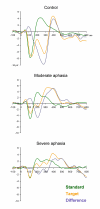Successful syllable detection in aphasia despite processing impairments as revealed by event-related potentials
- PMID: 17239239
- PMCID: PMC1784100
- DOI: 10.1186/1744-9081-3-6
Successful syllable detection in aphasia despite processing impairments as revealed by event-related potentials
Abstract
Background: The role of impaired sound and speech sound processing for auditory language comprehension deficits in aphasia is unclear. No electrophysiological studies of attended speech sound processing in aphasia have been performed for stimuli that are discriminable even for patients with severe auditory comprehension deficits.
Methods: Event-related brain potentials (ERPs) were used to study speech sound processing in a syllable detection task in aphasia. In an oddball paradigm, the participants had to detect the infrequent target syllable /ta:/ amongst the frequent standard syllable /ba:/. 10 subjects with moderate and 10 subjects with severe auditory comprehension impairment were compared to 11 healthy controls.
Results: N1 amplitude was reduced indicating impaired primary stimulus analysis; N1 reduction was a predictor for auditory comprehension impairment. N2 attenuation suggests reduced attended stimulus classification and discrimination. However, all aphasic patients were able to discriminate the stimuli almost without errors, and processes related to the target identification (P3) were not significantly reduced. The aphasic subjects might have discriminated the stimuli by purely auditory differences, while the ERP results reveal a reduction of language-related processing which however did not prevent performing the task. Topographic differences between aphasic subgroups and controls indicate compensatory changes in activation.
Conclusion: Stimulus processing in early time windows (N1, N2) is altered in aphasics with adverse consequences for auditory comprehension of complex language material, while allowing performance of simpler tasks (syllable detection). Compensational patterns of speech sound processing may be activated in syllable detection, but may not be functional in more complex tasks. The degree to which compensational processes can be activated probably varies depending on factors as lesion site, time after injury, and language task.
Figures







Similar articles
-
Event-related potentials indicate bi-hemispherical changes in speech sound processing during aphasia rehabilitation.J Rehabil Med. 2007 Oct;39(8):658-61. doi: 10.2340/16501977-0112. J Rehabil Med. 2007. PMID: 17896059
-
Contribution of spectrotemporal features on auditory event-related potentials elicited by consonant-vowel syllables.Ear Hear. 2009 Dec;30(6):704-12. doi: 10.1097/AUD.0b013e3181b1d42d. Ear Hear. 2009. PMID: 19672195
-
Event-related potential and autonomic signs of maladaptive information processing during an auditory oddball task in panic disorder.Int J Psychophysiol. 2009 Oct;74(1):34-44. doi: 10.1016/j.ijpsycho.2009.07.001. Epub 2009 Jul 14. Int J Psychophysiol. 2009. PMID: 19607864
-
Auditory Discrimination in Autism Spectrum Disorder.Front Neurosci. 2021 Jun 15;15:651209. doi: 10.3389/fnins.2021.651209. eCollection 2021. Front Neurosci. 2021. PMID: 34211363 Free PMC article. Review.
-
The role and use of event-related potentials in aphasia: A scoping review.Brain Lang. 2021 Aug;219:104966. doi: 10.1016/j.bandl.2021.104966. Epub 2021 May 24. Brain Lang. 2021. PMID: 34044294
Cited by
-
Examining cortical tracking of the speech envelope in post-stroke aphasia.Front Hum Neurosci. 2023 Sep 14;17:1122480. doi: 10.3389/fnhum.2023.1122480. eCollection 2023. Front Hum Neurosci. 2023. PMID: 37780966 Free PMC article.
-
Exploring neural tracking of acoustic and linguistic speech representations in individuals with post-stroke aphasia.Hum Brain Mapp. 2024 Jun 1;45(8):e26676. doi: 10.1002/hbm.26676. Hum Brain Mapp. 2024. PMID: 38798131 Free PMC article.
-
Electrophysiological Changes in Patients with Post-stroke Aphasia: A Systematic Review.Brain Topogr. 2023 Mar;36(2):135-171. doi: 10.1007/s10548-023-00941-4. Epub 2023 Feb 7. Brain Topogr. 2023. PMID: 36749552
-
Effect of acute moderate exercise on cognitive event-related potentials n100, p200, n200, and interpeak latencies.Indian J Psychol Med. 2010 Jul;32(2):131-5. doi: 10.4103/0253-7176.78511. Indian J Psychol Med. 2010. PMID: 21716775 Free PMC article.
-
The nature of hemispheric specialization for prosody perception.Cogn Affect Behav Neurosci. 2014 Sep;14(3):1104-14. doi: 10.3758/s13415-014-0255-1. Cogn Affect Behav Neurosci. 2014. PMID: 24515864
References
LinkOut - more resources
Full Text Sources

